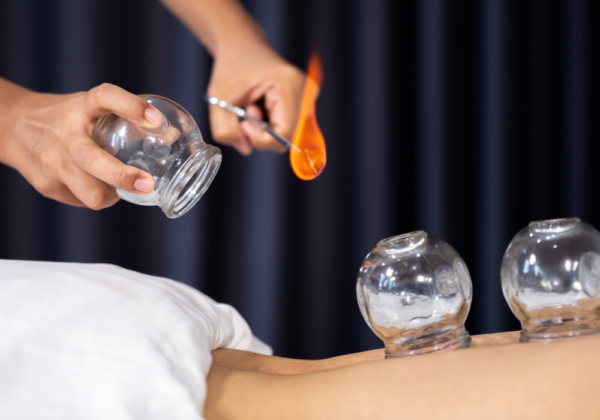 Ancient healing practices have always intrigued those seeking a more holistic approach to wellness. One such practice, cupping therapy, has been around for centuries but is currently experiencing a resurgence in popularity. Originating from ancient Chinese and Middle Eastern cultures, cupping therapy involves placing cups on the skin to create suction. This seemingly simple technique offers a myriad of health benefits that can rejuvenate the body and mind.
Ancient healing practices have always intrigued those seeking a more holistic approach to wellness. One such practice, cupping therapy, has been around for centuries but is currently experiencing a resurgence in popularity. Originating from ancient Chinese and Middle Eastern cultures, cupping therapy involves placing cups on the skin to create suction. This seemingly simple technique offers a myriad of health benefits that can rejuvenate the body and mind.
In this blog post, we’ll explore the fascinating world of cupping therapy. You’ll learn about its history, various methods and techniques, and the impressive health benefits it offers. We’ll also discuss safety precautions to ensure you get the most out of your cupping experience with minimal risk. If you’re a wellness seeker or holistic health enthusiast, this guide will provide valuable insights into how cupping therapy can enhance your well-being.
Methods and Techniques
Dry Cupping
Dry cupping is the most common form of this therapy. It involves placing suction cups on the skin without any incisions. The suction pulls the skin slightly upward, increasing blood flow to the area. This technique is particularly effective for relieving muscle tension and promoting relaxation. Practitioners often use plastic or silicone cups that can be easily adjusted for the desired level of suction.
Wet Cupping
Wet cupping takes the process a step further by incorporating small, superficial cuts on the skin before applying the suction cups. This method aims to remove toxins from the body by drawing out small amounts of blood. Wet cupping is believed to offer additional therapeutic benefits, such as improved immune function and enhanced detoxification. However, it’s crucial to seek a qualified practitioner for this method to minimize the risk of infection.
 Fire Cupping
Fire Cupping
Fire cupping is a more traditional technique that uses heat to create suction. A cotton ball soaked in alcohol is briefly ignited and placed inside the cup to remove oxygen. The cup is then quickly applied to the skin, where the cooling air creates a vacuum effect. This method is often used for deep-tissue massage and to alleviate respiratory conditions like asthma and bronchitis.
Suction Cupping
Suction cupping is a modern variation that employs a mechanical pump to create suction instead of heat or manual pressure. This method allows for more precise control over the level of suction, making it suitable for sensitive areas or individuals new to cupping therapy. Suction cupping is versatile and can be used for a range of conditions, from chronic pain to digestive issues.
Health Benefits
Pain Relief
One of the most celebrated benefits of cupping therapy is its ability to relieve pain. The suction created by the cups helps to loosen tight muscles and fascia, reducing discomfort in areas like the back, shoulders, and neck. Many athletes and individuals with chronic pain turn to cupping as a natural alternative to painkillers and other conventional treatments.
Improved Blood Flow
Cupping therapy also enhances blood circulation, which is essential for overall health. By drawing blood to the surface of the skin, cupping helps to oxygenate tissues and promote healing. Improved blood flow can lead to faster recovery times for injuries, reduced inflammation, and better overall physical performance.
Relaxation and Stress Relief
The calming effects of cupping therapy are another reason why it’s gaining popularity. The gentle pulling sensation of the cups can trigger the body’s relaxation response, helping to lower stress levels and induce a state of deep relaxation. Many people find that cupping therapy complements other stress-relief practices like yoga and meditation.
Safety and Precautions
Choosing a Qualified Practitioner
While cupping therapy is generally safe, it’s essential to choose a qualified practitioner to ensure the best results. Look for therapists who are certified and have experience in cupping techniques. A skilled practitioner will know how to apply the cups correctly and can adjust the treatment to suit your specific needs.
Possible Side Effects
Like any therapeutic practice, cupping therapy comes with potential side effects. Common reactions include temporary bruising, skin irritation, and mild discomfort. These side effects are usually harmless and subside within a few days. However, more severe reactions like infections can occur if the procedure is not performed correctly, particularly with wet cupping. Always follow aftercare instructions provided by your practitioner to minimize risks.
Contraindications
Cupping therapy may not be suitable for everyone. Individuals with certain medical conditions, such as clotting disorders, skin infections, or severe chronic illnesses, should consult their healthcare provider before undergoing cupping therapy. Pregnant women and individuals with very thin or sensitive skin should also exercise caution.
Cupping therapy offers a unique and effective way to enhance your overall well-being. From pain relief and improved blood flow to relaxation and stress relief, the benefits of this ancient practice are extensive. By understanding the different methods and techniques, you can choose the one that best suits your needs and preferences.
If you’re curious about trying cupping therapy, we encourage you to book a session with a reputable wellness center. Experience the rejuvenating effects of this age-old practice for yourself and join the growing community of holistic health enthusiasts who swear by its benefits.
Ready to elevate your wellness routine? Click here to find a qualified cupping therapist near you and start your journey toward better health today.

